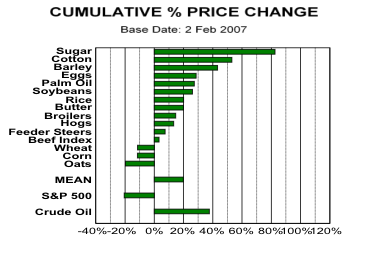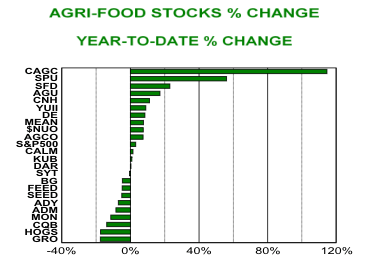Agri-Food's Stock Rotation Expectations for 2010
Commodities / Agricultural Commodities Mar 16, 2010 - 01:28 AM GMTBy: Ned_W_Schmidt
 THE benchmarks chosen by a nation say a lot about the future that nation will have. In the U.S. we seem to have chosen as one benchmark how often the central bank can create an over inflated stock market. Or, success is the percentage of the nation's mortgages financed by the government. Those benchmarks are reflected in the dismal leadership at the Federal Reserve.
THE benchmarks chosen by a nation say a lot about the future that nation will have. In the U.S. we seem to have chosen as one benchmark how often the central bank can create an over inflated stock market. Or, success is the percentage of the nation's mortgages financed by the government. Those benchmarks are reflected in the dismal leadership at the Federal Reserve.
Rather than a meritocracy, leaders are chosen as if a giant social experiment of a board game was being played. Or perhaps the benchmark for the national government is how many wealth destroying policies can be implemented in a short period of time. The future for the U.S. can only be dismal when such benchmarks are chosen to be pursued by uninspiring leadership. Little wonder Gold is US$1,100.
China seems, however, to have chosen a far different set of benchmarks. That list might include how many million people rise to the middle class, how many millionaires can be created, how many thousands of miles of road and rail can be created, how soon they can get to the moon, how many college graduates can they produce, etc. Which set of benchmarks, those chosen by the U.S. or those chosen by China, are more likely to create a prosperous society in the future? Which nation is changing the way the world works? Which will determine the price of gasoline and corn in the next decade? And finally, who is Mr. Bo?

The incremental demand for Agri-Food created by the largest migration of people in China into the middle class in all of history can be observed in the prices for Agri-Food. Chinese demand has changed the pricing environment for Agri-Food as has never been done in peace time. They now consume a quarter of the world's entire production of soybeans. As can be observed in the above chart, financial assets have experienced a negative return while the median price change for Agri-Food has been about +20%.
In this past year, as shown in the chart below, the Federal Reserve has been able to reinflate a bubble in financial asset prices. Great has been the praise heaped on those bubble-inducers for their success. But, just how successful have they been? As can be observed in the chart below, a mere bale of cotton has produced a far greater return than U.S. stocks. And as the previous chart shows, that bale of cotton held value far more than the stock market. That bowl of sugar, chart below, on your kitchen table has performed about as well as the U.S. stock market this past year.

The average gain for Agri-Food prices, as shown in the above chart, has been more than 20% in the trailing year. As a consequence of that excellent advance, the Agri-Food stocks produced a gain of more than 100%, as we showed in our last article. They will of course do far less in the year ahead. If one owns Gold in part due to the shift of economic power to China, then prospering from China's purchases of soybeans is a natural next step. China may never buy an ounce of foreign Gold, but they will be swapping money for corn with Nebraska farmers as they become a net importer of corn.

While the Agri-Food stocks were one of the strongest groups in the past year, stock rotation does occur on a regular basis. As the above chart portrays, the recent performance of the Agri-Food stocks includes both some winners and some losers. Those laggards may make a good match with the Gold in your portfolio as China, and soon India, consume the world's Agri-Food harvest.
Only the naive would deny that Chinese demand for resources has and will alter the pricing of all natural resources, including Agri-Food, in the years ahead. Group rotation in the equity markets may provide an opportunity for you to harvest some of these Agri-Food benefits. While you sit gloating over your Gold profits, do some research on how China and India are changing the price of what we eat. Not doing so may create the necessity of selling your Gold to feed you family in the years ahead. One place to start is: www.agrifoodvalueview.com
By Ned W Schmidt CFA, CEBS
AGRI-FOOD THOUGHTS is from Ned W. Schmidt,CFA,CEBS, publisher of The Agri-Food Value View , a monthly exploration of the Agri-Food grand cycle being created by China, India, and Eco-energy. To receive the most recent issue of this publication, use this link: http://home.att.net/~nwschmidt/Order_AgriValue.html
Copyright © 2010 Ned W. Schmidt - All Rights Reserved
Ned W Schmidt Archive |
© 2005-2022 http://www.MarketOracle.co.uk - The Market Oracle is a FREE Daily Financial Markets Analysis & Forecasting online publication.



